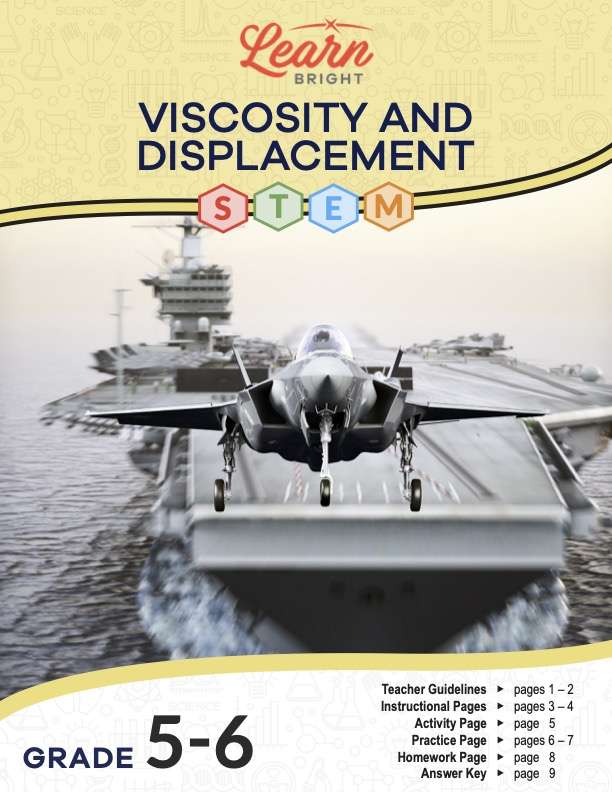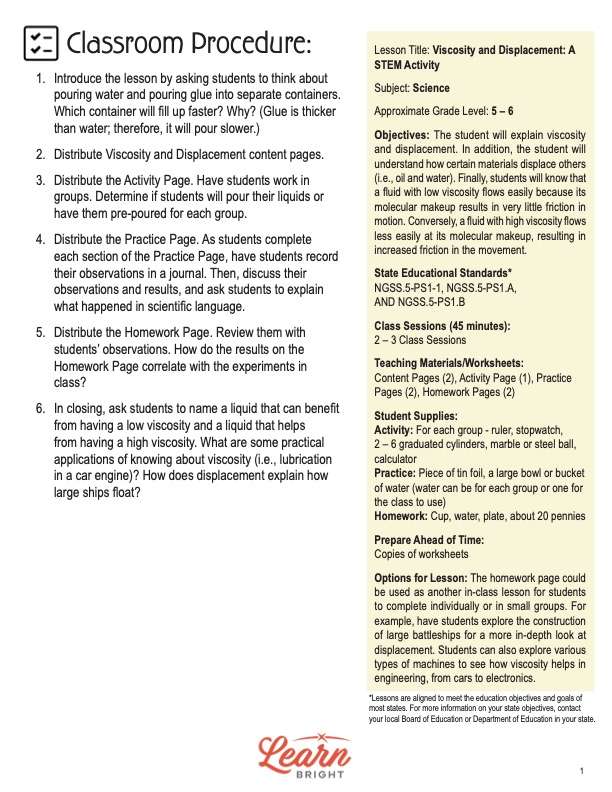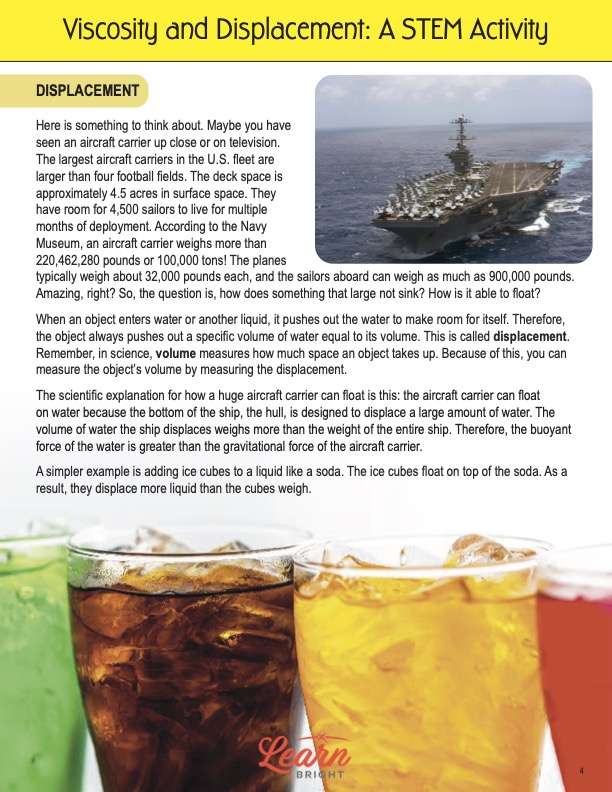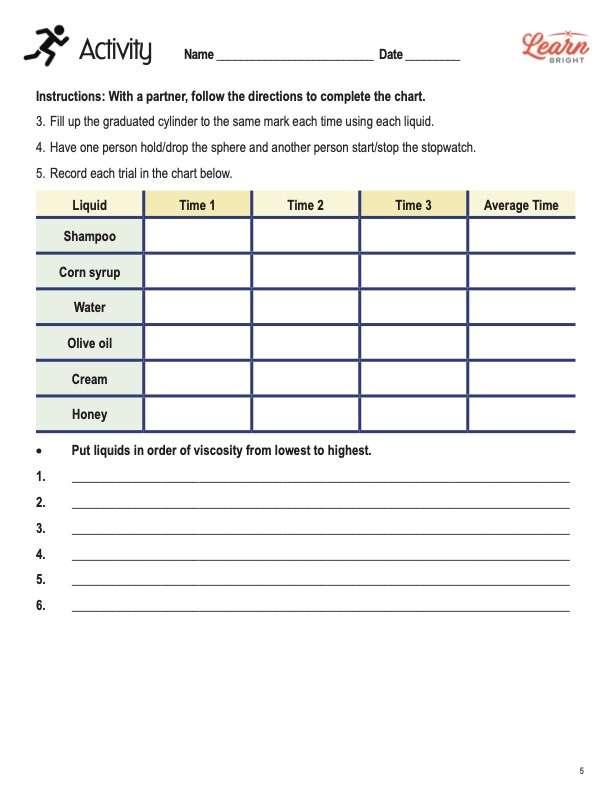Description
What our Viscosity and Displacement STEM lesson plan includes
Lesson Objectives and Overview: Viscosity and Displacement STEM explores these concepts in a fun way. Students will understand how certain materials displace others, such as oil and water. They will discover that fluids with a low viscosity flow easily while those with a high viscosity flow less easily. This lesson is for students in 5th grade and 6th grade.
Classroom Procedure
Every lesson plan provides you with a classroom procedure page that outlines a step-by-step guide to follow. You do not have to follow the guide exactly. The guide helps you organize the lesson and details when to hand out worksheets. It also lists information in the yellow box that you might find useful. You will find the lesson objectives, state standards, and number of class sessions the lesson should take to complete in this area. In addition, it describes the supplies you will need as well as what and how you need to prepare beforehand. The materials you need for this lesson include rulers, stopwatches, marbles, tin foil, cups, water, and pennies.
Options for Lesson
You can check out the “Options for Lesson” section of the classroom procedure page for additional suggestions for ideas and activities to incorporate into the lesson. The homework page could be used as another in-class lesson for students to complete individually or in small groups. For example, have students explore the construction of large battleships for a more in-depth look at displacement. Students can also explore various types of machines to see how viscosity helps in engineering, from cars to electronics.
Teacher Notes
The paragraph on this page gives you a little more information on the lesson overall and describes what you may want to focus your teaching on. The blank lines are available for you to write out any thoughts or ideas you have as you prepare.
VISCOSITY AND DISPLACEMENT STEM LESSON PLAN CONTENT PAGES
Viscosity
the Viscosity and Displacement STEM lesson plan has two content pages. Viscosity comes from the Latin word viscum, meaning sticky. It is a physical property of fluids. Think about pouring a glass of water and then a glass of honey. The water and honey will flow at different rates. Most fluids will offer some resistance to motion, in this case, pouring. This resistance is called viscosity. Viscosity is defined as the measure of a fluid’s resistance to flow. It can be considered a measure of a fluid’s thickness or resistance to objects passing through it.
Water has a low viscosity. It flows easily because its molecular makeup results in very little friction when it is in motion. Honey has a high viscosity. It resists motion because it has strong intermolecular forces, which creates a lot of internal friction.
The viscosity of a liquid decreases when the temperature of the fluid increases. That means when you heat a liquid, it will generally flow much easier. For example, think about putting honey in the microwave for 15 seconds. The honey gets thinner, and the viscosity increases, making it much more like pouring water.
There are two ways to measure viscosity—dynamic and kinematic. Dynamic viscosity is the resistance to flow when you apply an external force. Kinematic viscosity is the resistance to flow under the weight of gravity. The basic way to measure viscosity is to drop a sphere through a fluid and time the fall of the sphere. The slower it falls, the greater the viscosity. While this works great, scientists wanted a more accurate way to measure viscosity, so they invented a viscometer. A U-tube or Ostwald viscometer consists of two reservoir bulbs and a capillary tube.
Displacement
Maybe you have seen an aircraft carrier up close or on television. The largest aircraft carriers in the U.S. fleet are larger than four football fields. The deck space is approximately 4.5 acres in surface space. They have room for 4,500 sailors to live for multiple months of deployment. According to the Navy Museum, an aircraft carrier weighs more than 220,462,280 pounds or 100,000 tons! The planes typically weigh about 32,000 pounds each, and the sailors aboard can weigh as much as 900,000 pounds. So, the question is, how does something that large not sink? How is it able to float?
When an object enters water or another liquid, it pushes out the water to make room for itself. Therefore, the object always pushes out a specific volume of water equal to its volume. This is called displacement. Remember, in science, volume measures how much space an object takes up. Because of this, you can measure the object’s volume by measuring the displacement.
The scientific explanation for how a huge aircraft carrier can float is this: The aircraft carrier can float on water because the bottom of the ship, the hull, is designed to displace a large amount of water. The volume of water the ship displaces weighs more than the weight of the entire ship. Therefore, the buoyant force of the water is greater than the gravitational force of the aircraft carrier.
A simpler example is adding ice cubes to a liquid like a soda. The ice cubes float on top of the soda. As a result, they displace more liquid than the cubes weigh.
VISCOSITY AND DISPLACEMENT STEM LESSON PLAN WORKSHEETS
The Viscosity and Displacement STEM lesson plan includes three worksheets: an activity worksheet, a practice worksheet, and a homework assignment. These worksheets will help students demonstrate what they learned throughout the lesson and reinforce the lesson concepts. The guide on the classroom procedure page outlines when to hand out each worksheet to your students.
RANK THE VISCOSITY ACTIVITY WORKSHEET
Students will work with partners for the activity. First they will fill up a graduated cylinder to the same mark with each type of liquid. One person will drop a steel ball or a marble into the liquid while the other controls the stopwatch. They will record what they find in the chart on the worksheet page.
They will repeat this process two more times for each liquid and then find the average time it took for the ball to drop to the bottom. Once they have completed the chart, students will order the liquids from lowest to highest viscosity level.
PROVE DISPLACEMENT PRACTICE WORKSHEET
For the practice worksheet, students will use different materials to make a canoe. (If you want, you can have students make several different sizes of canoe and use various liquids.) They will shape a piece of tinfoil into a canoe and fill a bowl with water. Before placing the canoe in the water, they will write whether they think it will sink or float. After they place the canoe in the water, they will write whether it sank or floated.
Then students will crumple the tinfoil into a ball, write what they think will happen, place the ball in the water, and write what actually happened. There are then two more prompts for them to answer based on what they learned during the experiment.
VISCOSITY AND DISPLACEMENT STEM HOMEWORK ASSIGNMENT
The homework assignment requires students to perform yet another experiment. Students will fill a plastic cup with water all the way to the brim without overflowing. Very slowly, they will add one penny at a time into the water. They will continue to add pennies and note what happens on the chart on the worksheet page. They must use the terms flat, dome, and overflow in the chart.
At the bottom of the worksheet, students will draw a picture that shows what happened at the beginning, middle, and end of the experiment.
Worksheet Answer Keys
The lesson plan provides answer keys for the practice and homework worksheets. Given the nature of the homework assignment, there will be some variation in students’ responses. There may also be a little variation on the practice when it comes to the canoes. However, students’ responses should closely mirror those of the answer key on the final two prompts. If you choose to administer the lesson pages to your students via PDF, you will need to save a new file that omits these pages. Otherwise, you can simply print out the applicable pages and keep these as reference for yourself when grading assignments.









